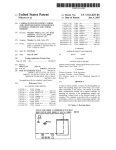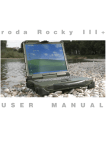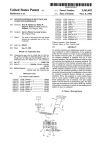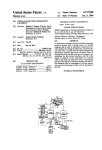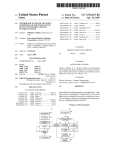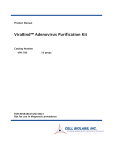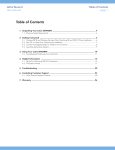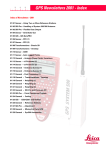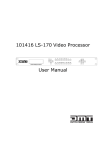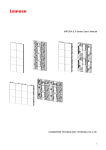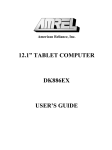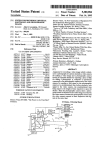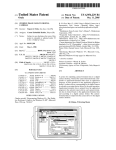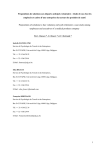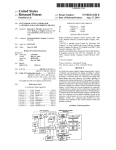Download Hand-manipulated electronic camera tethered to a personal computer
Transcript
‘ US005402170A Ulllted States Patent [19] [11] Patent Number: Parulski et al. [45] [54] HAND-MANIPULATED ELECTRONIC 5,040,068 CAMERA TE'I'HERED To A PERSONAL 5,065,229 11/1991 Tsai et al. . . . . COMPUTER 5,086,344 DLuna etal. .. [75] Inventors: Kenneth A. Parulski, Rochester; Ass1gnee: Eastman Kodak Company, . . . . .. 358/21 R ..... .. ass/213.15 8/1988 United Kingdom ........ .. H04N 3/15 ’ ~ _ _ ” User s Manual for Model 1 D1g_1ta1 Still Camera ; Dycam, Inc., 1991. User’s Manual-Kodak CCD 4000B Sync Camera, Eastman Kodak Co., Apr. 1991. [211 Appl- N0-= 938,573 [22] Filed: Aug. 31, 1992 _ _ Primary Examiner-Howard W. Britton Related [15- Alipllcatloll Data Attorney, Agent, or Firm-David M. Woods Continuation of Ser. No. 805,220, Dec. 11, 1991, abandoned. 2/1992 OTHER PUBLICATIONS “ Rochester’ N.Y_ Mar. 28, 1995 8/1991 Parulski et al. ................... .. 358/209 0308075 Acello, East Rochester, all of NY. _ [63] Date of Patent: FOREIGN PATENT DOCUMENTS Robert H- Hamel, Walworth; John J[73] 5,402,170 6 [57] ABSTRACT A portable, electronic camera is connectable to a com [51] Int. Cl. ........................................... .. H04N 5/232 putel. for capturing an image and providing the cap_ [521 U ' S ' Cl ' """"""""""""""""""""" " 348/211'’ 348/376348/552’ tured image to the computer for storage therewith. The camera ergonomically acts like an independent, self . [5 8] Fleld of searchl "" " 348/64’ 21 ’ 22 ’ [56] 3568/6550’ $352; ’ 2’ ’ 5/ References Cited functioning peripheral device while in actuality depend~ ing on instructions from the computer. The camera is remotely linked to the computer, e. g., by a cable, Us. PATENT DOCUMENTS thereby allowing mobility of the camera independent of the computer. The camera mcludes an electromc image 3,993,365 11/1976 Browne 6'1 al- 4 353/473 sensor, and circuit for driving the sensor to generate an Barrett . . . . . . . . . . . . . . . . . . .. image $133123; et a1‘ """ " remote link. The readiness of the computer to accept an 4’714’963 12/1987 wig; ' """" " to the computer through the "'358/909 image signal is manifested by operative device in the 354/412 camera, which condition the camera for image capture ____ ,_ 353/256 358/335 358/210 1n response to a status s1gna1 from the computer trans mitted through the remote hnk. In one embodiment, a capture switch is positioned on or with the camera for 3358/903 user engagement, whereby the operative device inhibits 4:738:526 4/1988 Larish 4,751,533 6/1938 Levine 4,805,037 2/1989 Noble . 4,827,347 5/1989 Bell ............... .. is 4,849,811 7/ 1939 Kleinerman 4,855,813 8/1989 R“Ss‘?u at al- -- 358/22 gee}: """"" actuation of the capture switch until receipt of the status signal. In another embodiment, the operative device 4:903:132 2/1990 $118322? .... .1 . . . . . .. 358/209 energiz.“ an. exp°§ure readiness indicator when the 4,942,477 7/1990 Nakamura .... .. ass/401 Status slgnal 1S recelved 5,019,699 5/ 1991 5,023,635 6/1991 Nealon ................................ .. 354/76 Koenck . . . . . . . . . .. 235/472 21 Claims, 4 Drawing Sheets LCD VIEWFINDER (1c 32 US. Patent FLASH Mar. 28, 1995 Sheet 2 0f 4 @22 5,402,170 LCD f \42 VIEWFINDER A T--> SHUTTER A26 VARIABLE I’ K400 ,28 ’ APERTURE BLUR FILTER 3G CFA 24/ FULL FRAME > SENSOR \_ 240 VIDEO AMPUFIER ' 54 VIDEO a. 30 A CLOCK DRIVERS MD CONVERTER BIAS CIRCUITS I SENSOR 56\ DIGITAL TIMING CDs BATTERY 144 ' ‘6% 58 DEFECT ‘ \: DEFECT ROM CORRECT/0N ' 62 \ l 66 \ /35 R68 CONTROL SHUTTER f 64 \ l SWITCH SCSI 38a \ I INDICATOR READY USY B FAULT —’ INTERFACE UGHTS 1 ,38b < \38 ' 38 6 FIG 2 - C0IvIvECT0R 34 J T0 l——> couguTER US. Patent Mar. 28, 1995 Sheet 3 of 4 5,402,170 CONNECT CAMERA CABLE AND TURN ON COMPUTER AND CAMERA OPEN CAMERA ‘CAPTURE’ APPUCATION SOFTWARE AND CHOOSE RESOLUTION. COLOR MODE. COMPRESSION MODE,AND MAXIMUM NUMBER OF IMAGES. DONE / \ ->( CAMERA ‘READY’ UGHT 0N >__> FROM CHOOSECAMERA OPTIONS ‘CAPTURE’ > COMPOSE PICTURE VIA OPTICAL V/EWFINDER AND DEPRESS' CAPTURE‘ BUTTON o/v CAMERA TO TAKE THE NEXT PICTURE APPUCATION SOFTWARE T0 ALLOW VIEWING 0F MULTIPLE 'THUMBNAIL' IMAGES AND DELEI'ION 0F UNWANTED IMAGES IMAGE SAVED TO DISC (FOLLOWING OPTIONAL COMPRESSION) ‘BUSY’ LIGHT ON CHECK IF THERE IS ROOM YES FOR MORE IMAGES FIG.3 TURN ON CAMERA ‘FULL’ UGHT US. Patent Mar. 28, 1995 IMAGE NAME NEWJMAGES MAX. NUMBER OF IMAGES Sheet 4 of 4 5,402,170 COMPRESSION IO MEMORY REOUIRED: IMBYTES MEMORY AVAILABLE: 5 MBYTES MODE COMPRESSION ON C] COMPRESSION OFF @Fi] RESOLUTION COLOR MODE 768 X 5/2 PIXELS ":5 24 BIT COLOR O 384 X 256 PIXELS D 8 BIT COLOR C] I92 X I28 PIXELS [3 8 BIT MONOCHROME FIG.4 1 5,402,170 2 HAND-MANIPULATED ELECTRONIC CAMERA ble. In one desirable application, a low cost electronic still camera would be tethered to a small, battery oper TETHERED TO A PERSONAL COMPUTER ated notebook or penpad personal computer which provides image processing, storage, and display of the This is a continuation of application Ser. No. 805,220, ?led Dec. 11, 1990, now abandoned. captured images. By relying on the computer to per form these tasks, the camera cost can be greatly re duced. In such an application, the computer would BACKGROUND OF THE INVENTION typically be slung over the shoulder or rested on a table, while the user held the camera to compose the image. 1. Field of the Invention This invention pertains to the ?eld of electronic imag 10 However, if the user must press buttons or pointers on the computer to capture each image, as is typical in the ing and, more particularly, to an image acquisition pe prior art, the system will be very unwieldy to use since ripheral operated as an input device to a personal com the user will have to hold the camera in the right posi puter or professional workstation. , 2. Background Art Video cameras and computer frame grabbers are well known in the prior art. A typical system employs a video motion camera (such as the CCD 4000 RGB tion with one hand, while operating the computer with the other hand. By tethering the camera to the computer, as exempli ?ed by the Faulkerson et al patent, it is possible to have both complex camera exposure functions and to control some computer functions from the camera itself. The as a TARGATM frame store board manufactured by 20 complex camera exposure functions remain in the cam Flash-Sync Camera manufactured by Eastman Kodak Co., Rochester, NY.) and a frame grabber board (such True Vision, Inc., Indianapolis, Ind.) attached to the PC bus of a personal computer or professional workstation. The camera provides the timing to interface with the video frame store board by activating the frame acquire era, however, which is contrary to the objective of low cost. Though it may be feasible, as done in the prior art, to download most complex processing to the computer, in effect slaving the camera to the computer, it is desir line of the frame store board whenever an external 25 able to maintain the ergonomics of a hand-held camera, voltage input to the camera is dropped low (e.g., by dropping the “Camera Acquire In” line to the CCD 4000 camera). While the external voltage input may be separately and directly enabled, it is customary when using a video camera (such as the CCD 4000 camera) with a personal computer to design software to activate the camera’s frame acquire line from the computer. To capture an image into the computer in such a customary application, the operator frames the subject while ob serving the live camera output on a video monitor, and 35 then interacts with the computer keyboard at the proper moment. The need to use the computer keyboard fre quently interferes with effective use of the camera. Other known scanners that interact with a host com puter include US. Pat. No. 4,901,364 (Faulkerson et a1) and US. Pat. No. 4,581,761 (Ichinokawa et a1). Faulker that is, to’ permit framing, exposure, ?ash, status indica tion, etc., without having to interact with the host com puter. What is needed is a design for a tethered com puter camera and associated computer software that allows the user to easily capture and store multiple images from the camera into the computer disk mem ory, without needing to interact with the computer at the instant each image is captured. SUMMARY OF THE INVENTION The invention pertains to a portable, electronic cam era connectable to a computer for capturing an image and providing the captured image to the computer for storage therewith. In accordance with the invention, the camera ergonomically acts like an independent, self-functioning peripheral device while in actuality depending on instructions from the computer. The cam era is linked by signal connection means to the com puter, e.g., in one embodiment by a cable, thereby al includes a plurality of function keys that are user-pro grammable so as to assume certain functions that are 45 lowing mobility of the camera independent of the com puter. The camera includes electronic image sensing ordinarily accessed through a keyboard. For instance, means, and means for driving the sensing means to gen the function keys can be programmed to provide move erate an image signal that is applied to the computer ment from ?eld-to-?eld within a spreadsheet program through the signal connection means. The readiness of while entering data using the scanner, without, e.g., son et al describes an interactive linear scanner system (for text) in which a hand-operated optical scanner requiring the user to use arrow keys on the computer 50 the computer to accept an image signal is manifested by keyboard. The camera exposure functions, however, such as control of a light source and the enablement of the optical scanning function, are controlled by a video processor located in the scanner. Moreover, the image operative means in the camera, which condition the camera for image capture in response to a status signal from the computer transmitted through the signal con nection means. In one embodiment, a capture switch is data is edited to eliminate duplicative character infor 55 positioned on or with the camera for user engagement, whereby the operative means inhibits actuation of the capture switch until receipt of the status signal. In an other embodiment, the operative means energizes an exposure readiness indicator when the status signal is detached from a hand-operated scarmer. A switch on the bottom of the scarmer triggers the detached proces 60 received. mation between successive image data frames. The edited frame data is then transmitted via data bus to a host computer. In Ichinokawa et al, a video processor is sor when the scanner is pushed down upon a document. The processor then receives image data and additional information (e.g., for switching from draw to erase, BRIEF DESCRIPTION OF THE DRAWING The invention will be described in relation to the setting coordinates, and changing magni?cation) from drawings, in which the scanner, in turn providing processed data to a host 65 FIG. 1 is a schematic diagram of an image capture system for a computer, including a portable, electronic . computer. As alluded to earlier, it is desirable to disassociate the camera from keyboard interaction to the extent possi camera connected to a conventional personal computer according to the invention; 3 5,402,170 FIG. 2 is a block diagram of a preferred implementa tion of the camera illustrated in FIG. 1; FIG. 3 is a ?ow diagram showing the operation of the camera of FIG. 2; and FIG. 4 shows a typical menu selection presented to the user by the computer. DESCRIPTION OF THE PREFERRED EMBODIMENTS Referring ?rst to FIG. 1, an electronic camera 10 is coupled to a personal computer 12 through a computer interface 14. The camera 10 is preferably remotely linked to the computer 12 with a cable 16, thus allowing a certain amount of mobility for the camera 10 indepen dent of the computer 12. The interface 14 depends on the interface standard used; for example, if the interface standard accommodates an analog NTSC video signal, the interface 14 is typically a frame store board 14a, 4 to specify a minimum or maximum number of signals or signal connections. For instance, if the camera 10 pro vides a continuous stream of image signals, the CAP TURE OUT line is needed to single out one image frame for capture by the computer 12. Of course, de pending upon the embodiment, this could be a separate signal (CAPTURE OUT) or it could be, e.g., a bit set in a header that travels with the image signal (IMAGE OUT). In the latter case, a separate CAPTURE OUT signal is unnecessary. If the camera 10 provides a single still-image signal (rather than a stream of image signals), the mere existence of an image signal on the IMAGE OUT line is determinative of the captured image. In that case, there is no need to communicate a separate CAP TURE OUT signal to single out a particular image instance; if the Small Computer System Interface frame. A status signal on the CONTROL IN line controls usage of the shutter release 36 such that the shutter release 36only activates a still capture, or pulses the CAPTURE OUT line, when the status signal is set. Several alternatives are possible: the status signal could (SCSI) is used, the interface 14 is a SCSI interface board 14b. The choice of interface, as will be shown, deter the shutter release 36 will have no effect until the lamp mines the type of signal processing employed in the 38 is extinguished (i.e., continued depression of the such as the aforementioned TARGA TM board. Alter natively, a digital interface standard may be used; for illuminate the indicator lamp 38, passively showing that camera 10. The computer 12 additionally includes a 25 shutter release 36 would not be recognized by the com conventional keyboard 18 and a conventional disk drive puter 12). Alternatively, the status signal could actively 20, the latter being used to store pictures captured by inhibit the shutter release 36, e.g., by preventing the the camera 10. Although not shown, the computer 12 generation of a CAPTURE OUT signal or the initiation of a still exposure. Moreover, the CONTROL IN line includes the usual RAM storage for buffering incoming image data. The camera 10 includes an optical system, repre sented by the lens 22, for directing image light from an may have separate status signals for enabling the shutter release 36 and illuminating the lamp 38, or if the two states are mutually exclusive, the two conditions of a single binary status signal may manifest both states. Furthermore, in a preferred implementation, the CON optionally include, in certain embodiments, a shutter 26 and a diaphragm 28 for regulating the quantity of image 35 TROL IN line includes several status components for illuminating several different status indicator lamps. light exposed upon the image sensor 24. The sensor 24 object to an image sensor 24. The optical system may is biased and driven by a sensor clock generator 30, which provides the signals used to clock an output image signal from the sensor 24. The output image sig nal is applied to a signal processor/controller 32, the complexity and type of processing and control varying In one implementation of the invention, the sensor 24 is a scan rate video sensor producing a motion video signal and the signal processor/controller 32 includes a stage for converting the image signal into an analog NTSC video signal, which is transmitted through the connector 34 to the computer 12 as the IMAGE OUT signal. Typically the interface 14in such an application processor 32 exits the camera through a connector 34, is a framestore board 14a. In the implementation just which accepts a suitable connector (not shown) on the cable 16. The camera 10 further includes a shutter but 45 mentioned, actuation of the shutter switch 36 pulses the according to the embodiment. The output of the signal ton 36 for initiating either an exposure sequence or a CAPTURE OUT line, which is connected through the frame capture, depending upon the embodiment; a sta tus indicator 38, which may include a liquid crystal connector 34 to, e.g., the capture control line of the framestore board 140. The framestore board 14a then captures a frame from the continuous video signal out put on the IMAGE OUT line. An appropriate signal on display (LCD) panel or a plurality of indicator lamps for indicating the status of the computer 12 to the user the CONTROL IN line to the signal processor/con (that is, “ready” for another picture, or “busy” process troller 32 activates the shutter button 36, that is, allows ing the just-taken picture) a view?nder 40, which may the signal processor/controller 32 to output a capture be an optical view?nder (as represented by the lens 40a, pulse on the CAPTURE OUT line; likewise, appropri 40b) or an electronic view?nder (as represented by the LCD display 40c connected by broken line 40d to the 55 ate signals on the CONTROL IN line energize appro priate indicator lights 38 to tell the user the status of the signal processor/controller 32); an electronic ?ash 42, computer 12, that is, whether the computer 12 is ready which may be detachable or integrally formed with the to capture the next image, whether it is in the process of camera; and a power supply 44 for powering the vari storing the present image to the disk drive 30, or ous circuits and electrically-powered components in the camera 10. whether the drive 20 is full. For purposes of broadly describing the functions of the camera 10, the signal processor/controller 32 is is shown in FIG. 2 in block diagram form wherein shown as outputting CAPTURE OUT and IMAGE identical reference characters are used to identify com A second, preferred implementation of the invention, ponents similar to those described in FIG. 1. In this OUT signals to the computer 12. In particular, the pro cessor/controller 32 is operative to condition the cam 65 implementation the signal processor/controller 32 gen erates a digital color image signal for application era for image capture in response to a CONTROL IN through the connector 34 to the SCSI interface board signal received from the computer 12. These signals are 14b (shown in FIG. 1). A still image signal is generated exemplary of the supported functions and are not meant 5 5,402,170 6 by the image sensor 24, which in this embodiment in porated herein by reference.) The user also speci?es the cludes a full-frame sensor 24a, such as the Model KAF image group name and the maximum number of images to be saved. The computer then calculates the required storage space to determine if the required amount of 0400 (768x 512 pixels) manufactured by Eastman Kodak Company, and a “3-Green” color ?lter array 24b. The principle of the “3-green” color ?lter pattern, disk memory is sufficient. Once the selections are made, the camera “ready” lamp 38a is lit, and the user can along with the concomitant use of a blur ?lter 50, such as a birefringent optical ?lter, is described in US. Pat. close the computer (if required) and sling it over the No. 4,663,661, “Single Sensor Color Video Camera with Blurring Filter” which is assigned to the same assignee as the present application and incorporated herein by reference. The signal processor/controller 32 includes a video ampli?er 52, which applies an ampli ?ed video signal to a video analog/digital (A/D) con verter 54. Sampling noise is removed from the digital video signal in a digital correlated double sampling circuit 56. (A suitable digital sampling circuit 56 is dis closed in Ser. No. 522,030, ?led May 11, 1990, entitled “Digital Correlated Double Sampling Circuit for Sam pling the Output of an Image Sensor”, which is an al lowed application assigned to the same assignee as the shoulder while holding the camera. The user frames the image and depresses the capture button 36. This begins a sequence which ?res the flash 42 if required, actuates the shutter 26, and reads the digitized image sensor data, a line at a time, over the SCSI bus (connection 16) to the computer RAM mem ory. Depending on the capture options selected, the data is either stored directly from RAM to the hard disc 20 (or other non-volatile computer memory), is com pressed using, e.g., the aforementioned known image compression method, etc. The ?rst image is stored as image group name 1, and subsequent images are stored as image group name 2, image group name 3, etc. While present application and incorporated herein by refer this happens, the computer turns off the “ready” lamp ence.) Imager defects are corrected in a defect correc tion stage 58 (the actual defect locations are stored in a defect ROM 60). Red, green, and blue look up tables (LUTs) 62 are provided for gamma correction and white balance. The output signals are converted to the SCSI standard by a SCSI interface 64 and transmitted through the connector 34 to the SCSI interface board 14b in the computer 12. A programmed microprocessor-driven controller 66 provides the commands, instructions, and signals neces 38a and illuminates the “busy” lamp 38b, so the user knows that the computer operations are occurring, without having to look at the computer display screen. Assuming that the current image number is less than the maximum number of images so that there is room to store more images (and that the flash has recharged if required), the “ready” lamp 380 is illuminated so that 30 sary to operate the camera, in particular responding to control inputs from the computer 12 through the SCSI interface 64 to initiate a still exposure sequence subject to actuation of the shutter switch 36. In other words, the controller 66 waits for instructions from the com puter 12 before recognizing an input from the shutter switch 36. During the interim, indicator lamps 38a, 38b, 38c are illuminated to indicate the condition of the cam era 10 relative to the computer 12. The indicator lamps are illuminated by a signal from the controller 66 pursu ant either to speci?c instructions from the computer 12 or, particularly if only one lamp is used, by the absence the user knows that the next image may be framed and captured. If the disk drive 20 (or other storage device) is full, or other problems are noted, then the “fault” lamp 38c is illuminated. The user then proceeds to sub stitute another disk (if drive 20 uses removable media), move or delete some images, or otherwise correct the problem, and the “ready” lamp 38a is again illuminated. If the storage medium is ?lled, a mosaic of small, “thumbnail” images may be produced on a single screen image of the computer’s monitor to facilitate choice of unwanted images. The invention has been described in detail with par ticular reference to a presently preferred embodiment, but it will be understood that variations and modi?ca tions can be effected within the spirit and scope of the of an enable signal for the shutter switch 36. The camera shown in block form in FIG. 2 is particu 45 invention. For instance, while analog and SCSI inter faces have been described, it is also feasible to use the larly adapted for connection through a digital interface, parallel and serial ports conventionally available on a such as a SCSI interface, to a small light-weight com personal computer. puter, such as a laptop computer with an LCD display What is claimed is: and a large capacity hard disk drive. With that utility in mind, the operation of the camera of FIG. 2 is described 50 1. A portable, electronic camera connectable to a computer for capturing an image and providing the in the self-explanatory ?ow-chart shown in FIG. 3. The captured image to the computer for storage therewith, user begins by connecting the camera 10 to the com said camera comprising: puter 12 and turning on the power supply 44. The user signal connection means for linking the camera to the opens a “tethered camera” application program in the computer; computer 12 and selects capture parameters from a 55 means for sensing an image; menu shown in FIG. 4. The options can include the means for driving said sensing means to generate an color mode (8 or 24 bit color or monochrome images), image signal corresponding to the image, and for storing the full resolution images or lower resolution subsampled images (e.g. allowing the user the choice of full resolution (e.g., 512x768 pixel) images or lower 60 resolution (e.g., 256>< 384, or 128x192 pixel) images, i.e., thereby using lower resolution to allow more im ages to be stored in the memory), storing compressed or uncompressed images, and so on. (A suitable image compression technique for images from a “3-green” 65 color image sensor is disclosed in US. Pat. No. 5,065,229, “Compression Method and Apparatus for Single-Sensor Color Imaging Systems”, which is incor applying the image signal to said signal connection means for transmission to the computer; operative means for conditioning the camera for image capture in response to the readiness of the computer for accepting an image signal, said opera tive means responsive to a status signal from the computer transmitted through said signal connec tion means, whereby the computer is adapted for storage of the image signal after providing the status signal; and 7 5,402,170 image signal corresponding to the image, and for applying the image signal to said signal connection signal, thereby capturing an image, and wherein said operative means inhibits actuation of said ex posure release means until receipt of said status 5 signal indicates that the computer is ready to re ceive the image signal. 2. A camera as claimed in claim 1 wherein the camera further comprises a capture switch for outputting a accepting an image signal, said indicating means responsive to a status signal from the computer transmitted through said signal connection means; and signal for initiating the capture of an image signal corresponding to a selected image, whereby the computer initiates storage of the image signal after providing the status signal and receiving the cap a still image in response to the occurrence of the capture command signal and the receipt of the status signal from the computer. 3. A camera as claimed in claim 1 wherein the camera 15 further comprises an exposure readiness indicator and ture command signal. 12. A camera as claimed in claim 11 for use with a computer including a framestore capture circuit having a capture input for actuating the capture of an image, wherein said operative means energizes said exposure readiness indicator when said status signal indicates that the computer is ready to receive the image signal. and wherein; 4. 'A camera as claimed in claim 3 wherein said expo 20 sure readiness indicator has a plurality of indicator states and wherein the status signal has a plurality of components each actuating a corresponding one of said indicator states to show that the computer is ready to said driving means generates a series of image signals corresponding to a series of images; and the capture command signal output by said capture switch is applied to the capture input of the frames tore capture circuit in order to initiate the capture of a particular image signal. receive an image signal, that the computer is busy pro cessing an image signal, and that a storage device in the computer is full. 13. A camera as claimed in claim 11 wherein said readiness indicating means toggles between two states indicating whether or not the computer is ready to 5. A camera as claimed in claim 1 wherein the image accept an image signal, and wherein said capture switch signal generated by said driving means comprises a is rendered effective in outputting a capture command stream of image signals corresponding to a stream of consecutive images, and wherein the camera further comprises a capture switch for outputting a capture command signal to the computer to identify an image signal after said readiness indicating means has changed to the state indicating that the computer is ready to accept an image signal. 14. A camera as claimed in claim 11 further including 35 6. A camera as claimed in claim 5 for use with a a cable interface connecting said signal connection means with the computer whereby the camera remains tethered to the computer. computer including a framestore capture circuit having a capture input for initiating the capture of an image, and wherein; the capture command signal output by said capture switch is applied to the capture input of the frames 15. A portable electronic camera connectable to a computer through a peripheral interface for capturing an image and providing the captured image over the interface for storage with the computer, said camera tore capture circuit in order to initiate the capture comprising: of a particular image signal. means for sensing an image and generating an image 7. A camera as claimed in claim 1 wherein speci?c image capture options are speci?ed through interaction signal; 45 with the computer, and wherein said driving means outputs a common image signal that is subsequently con?gured in the computer according to the speci?ed capture options. an interface controller for controlling the transmis sion of data between the camera and the computer; a capture switch for generating a capture signal that initiates a still exposure; means responsive to (a) a control signal from the 8. A camera as claimed in claim 7 wherein the speci?c image capture options are used for a multiplicity of images. means for transmission to the computer; means for indicating the readiness of the computer for a capture switch for outputting a capture command capture command signal, and wherein said driving means generates a single image signal corresponding to signal selected from the stream of image signals. 8 means for driving said sensing means to generate an exposure release mean connected to said driving means for initiating the generation of an image _ 9. A camera as claimed in claim 7 wherein said image capture options include storage of either a full resolu tion image or a subsampled image. 55 10. A camera as claimed in claim 7 wherein said sens ing means includes a color ?lter array for generating color-responsive signals and said image capture options include storage of either a color or a monochrome im age. computer transmitted through the interface con troller for enabling said sensing means to generate a still image signal and (b) actuation of said capture switch for triggering the enabled sensing means to capture a desired still image; and status indicator means responsive to a status signal from the computer transmitted through the inter face controller for indicating when the computer is ready to accept a still image signal. 16. A camera as claimed in claim 15 wherein said status signal is included with said control signal. 11. A portable, electronic camera connectable to a 17. A portable, electronic camera connectable to a computer for capturing an image and providing the captured image to the computer for storage therewith, computer for capturing an image according to image said camera comprising: capture options speci?ed by the computer and provid— ing the captured image to the computer for storage signal connection means for remotely linking the 65 therewith, said camera comprising: signal connection means for remotely attaching the camera to the computer, thereby allowing mobility camera to the computer and thereby allowing mo of the camera independent of the computer; bility of the camera independent of the computer; means for sensing an image; 9 5,402,170 10 for applying the image signal to said signal con means for sensing an image; means for driving said sensing means to generate an nection means for transmission to the computer; image signal corresponding to the image regardless of speci?ed image capture options, and applying and 4) operative means for conditioning the camera for image capture in response to the readiness of the said image signal to said signal connection means; a view?nder for viewing a plurality of images in order to select a desired image; and a capture switch for initiating the capture of an image signal and transmission thereof to the computer through said signal connection means, whereby the 10 computer processes the desired image according to computer for accepting an image signal, said operative means responsive to a status signal from the computer transmitted through said signal connection means, whereby the computer is adapted for storage of the image signal after providing the status signal; and b) a computer connectable to the camera for storing the speci?ed capture options after receipt of the capture command signal. the image according to speci?ed options dependent upon processing of the image signal, said computer 18. A camera as claimed in claim 17 wherein said capture options include the choice of either full resolu 15 tion or subsampled resolution, or color or monochrome comprising: 1) an image compression algorithm providing at least one mode of compression; reproduction. 19. A system including a camera and a computer for capturing a still electronic image, said system compris 20 g: a) a portable camera connectable to the computer for capturing the image and providing the captured image to the computer for storage therewith, said 2) means for selecting a speci?c image processing option, including the mode of compression, the resolution of the captured image as derived from the image signal, and the processing of color or monochrome images from the image signal; and 3) means for generating and transmitting the status signal to the camera. camera comprising: 20. A system as claimed in claim 19 wherein the speci 1) signal connection means for linking the camera 25 ?ed image processing options include application of the to the computer; 2) means for sensing an image, said sensing means having a maximum resolution and being capable of producing a color output; 3) means for driving said sensing means to generate an image signal corresponding to the image, and speci?ed options to a plurality of images. 21. A system as claimed in claim 19 wherein the speci 30 ?ed image processing options include the ability to limit the maximum number of captured images. * 35 45 50 55 60 65 * * * *










